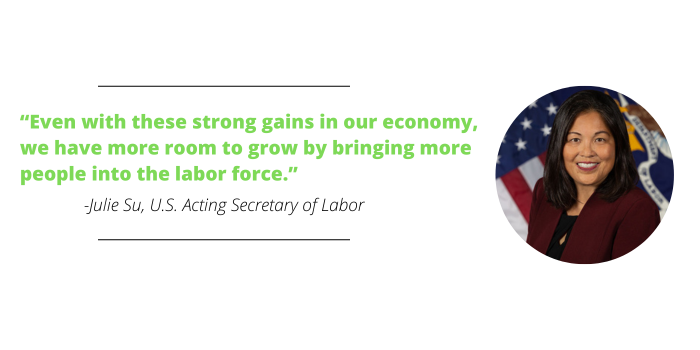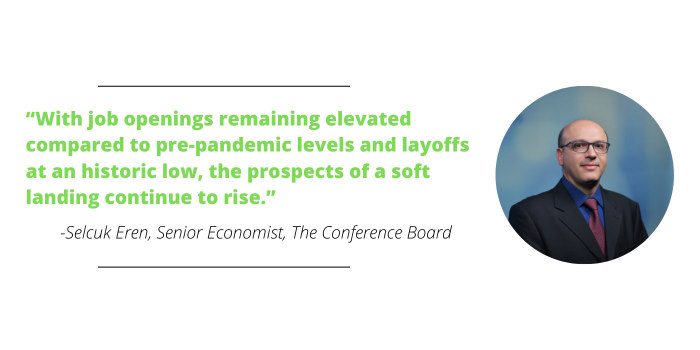Mapping The Employment Trends Shaping 2024’s Robust Labor Market

The U.S. economy added 353,000 jobs in January, the largest gain in a year, according to the Bureau of Labor Statistics. The unemployment rate held steady at 3.7%, remaining below 4% for two consecutive years, the longest stretch in more than 50 years.
“This strong jobs report also shows balanced, broad-based growth across sectors, with gains in retail, health care and professional and business services like engineering and management jobs,” says acting Secretary of Labor Julie Su. “Even with these strong gains in our economy, we have more room to grow by bringing more people into the labor force.”

The State Of The Job Market
Expect job growth to continue, according to the Conference Board Employment Trends Index (ETI), which increased in January to 113.71 from a downwardly revised 112.91 in December.
- When the ETI increases, which it has for a second straight month, employment is likely to grow as well.
The ETI now stands at its highest level since May 2023 and remains elevated compared to pre-pandemic levels, though still below its peak in March 2022, says Selcuk Eren, senior economist at The Conference Board.
“Payroll gains were economywide in January 2024 after being predominantly driven by three industries (healthcare and social assistance; leisure and hospitality; and government) in the second half of 2023,” Eren says.

“Temporary help services – an early indicator for hiring in other industries and a component of the ETI – added jobs in January, breaking the downward trend observed since April 2022. Furthermore, the percentage of consumers saying jobs were ‘hard to get’ in The Conference Board Consumer Confidence Survey – another ETI component – is back to single digits for the first time since March 2022. With job openings remaining elevated compared to pre-pandemic levels and layoffs at an historic low, the prospects of a soft landing continue to rise.”
- However, the strength of the labor market indicates that the Federal Reserve won’t be cutting its federal funds target rate, which has remained at 5.25% to 5.5% since the summer, Reuters reported.
- The rate sets a benchmark for other interest rates, such as credit cards, mortgages and auto loans.
Employment Law Trends To Follow In 2024
While employers should anticipate a strong labor market to continue in 2024, there are other trends to keep an eye on, as worker-friendly legislation gains traction on both the federal and state level.
- Independent Contractor Rule
The US. Department of Labor (DoL) announced last month what it has deemed a final rule on the classification of workers as either employees or independent contractors under the Fair Labor Standards Act.
The final rule will replace the 2021 Independent Contractor Rule that the DoL has deemed inconsistent with the law and judicial precedent. Instead of adopting the previously considered “ABC” test that required three specific factors, the new rule restores multifactor analysis to determine the classification of an employee.
The rule includes six factors that guide the analysis and determination of whether a worker is an employee or independent contractor. Those factors include:
- Any opportunity for profit or loss a worker might have.
- The financial stake and nature of any resources a worker has invested in the work.
- The degree of permanence of the work relationship.
- The degree of control an employer has over the person’s work.
- Whether the work the person does is essential to the employer’s business.
- The worker’s skill and initiative.
Notably, under the new rule, a worker cannot waive employee status and choose to be classified as an independent contractor. The DoL states, “The Supreme Court has explained that permitting employees to waive FLSA rights would harm other employees and undermine the Act’s goal of eliminating unfair methods of competition in commerce.”
PPAI has taken a public stance against the proposed DoL rule in the past, arguing that the promotional products industry has been unfairly lumped with other industries in which workers are commonly misclassified as independent contractors against their wishes.
This final rule is set to be effective March 11, 2024.
- Non-Compete Clauses
In January 2023, the Federal Trade Commission (FTC) proposed a new rule that would ban employers from imposing noncompete clauses on their workers.
- Noncompete clauses are a contractual term between an employer and a worker that blocks the worker from working for a competing employer or starting a competing business, typically within a certain geographic area and period of time after the worker’s employment ends.
The FTC says that noncomplete clauses “prevent new businesses from forming, stifling entrepreneurship, and prevent novel innovation which would otherwise occur when workers are able to broadly share their ideas.”
- Several states, including California, Colorado, Illinois, Minnesota, Nevada, North Dakota, Oklahoma, Oregon and Washington, have already passed legislation to prohibit or limit the use of noncompete clauses.
A final ruling on the FTC proposal is expected in 2024. Regardless of how it plays out, it might be time for the promotional products industry to move beyond noncompete clauses.
- Paid Leave
Fifteen states and Washington D.C. currently have paid sick leave, and 11 states and Washington D.C. currently offer some type of paid family leave.
Some states, like California, are increasing the maximum hours that employees can accrue, and others are expanding their paid sick leave laws to include more covered uses.
- This year, Maryland employers begin paying their contributions with employees being able to apply for benefits in 2026, and Vermont will implement its voluntary paid family leave program in July.
- Delaware and Maine have passed paid leave laws which will go into effect in 2025 with benefits being paid out in 2026.
Only 27% of all U.S. workers have access to paid leave, according to the Bureau of Labor Statistics.
- Employment Discrimination
In September, the Equal Employment Opportunity Commission (EEOC) released its priorities for fiscal years 2024 through 2028.
These priorities include eliminating recruitment and hiring barriers, advancing equal pay for all workers and preventing and remedying systemic harassment. The rise in AI and machine learning playing a significant role in the hiring process has also caught the EEOC’s attention and will surely be analyzed in the years to come.
- More than half of PPAI 100 distributors (59%) and suppliers (55%) use AI in their business operations, according to PPAI Research.
In October, President Joe Biden issued an executive order that established new standards for AI safety and security. Among Biden’s goals with the executive order are:
- Prioritizing federal support for accelerating the development and use of privacy-preserving techniques.
- Developing principles and best practices to mitigate the harms and maximize the benefits of AI for workers.
- Catalyzing AI research across the United States through a pilot of the National AI Research Resource and expanded grants for AI research in vital areas, like healthcare and climate change.

